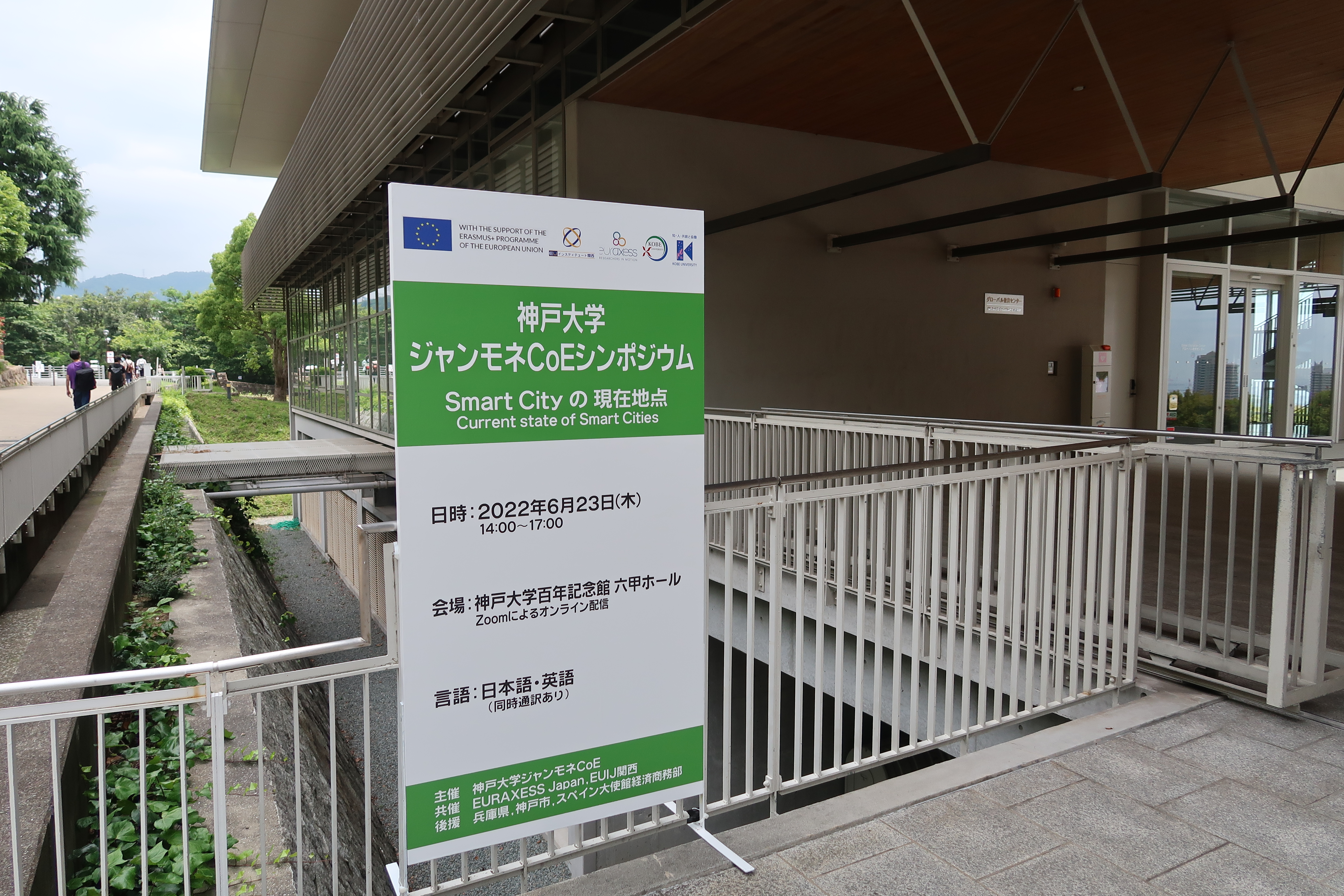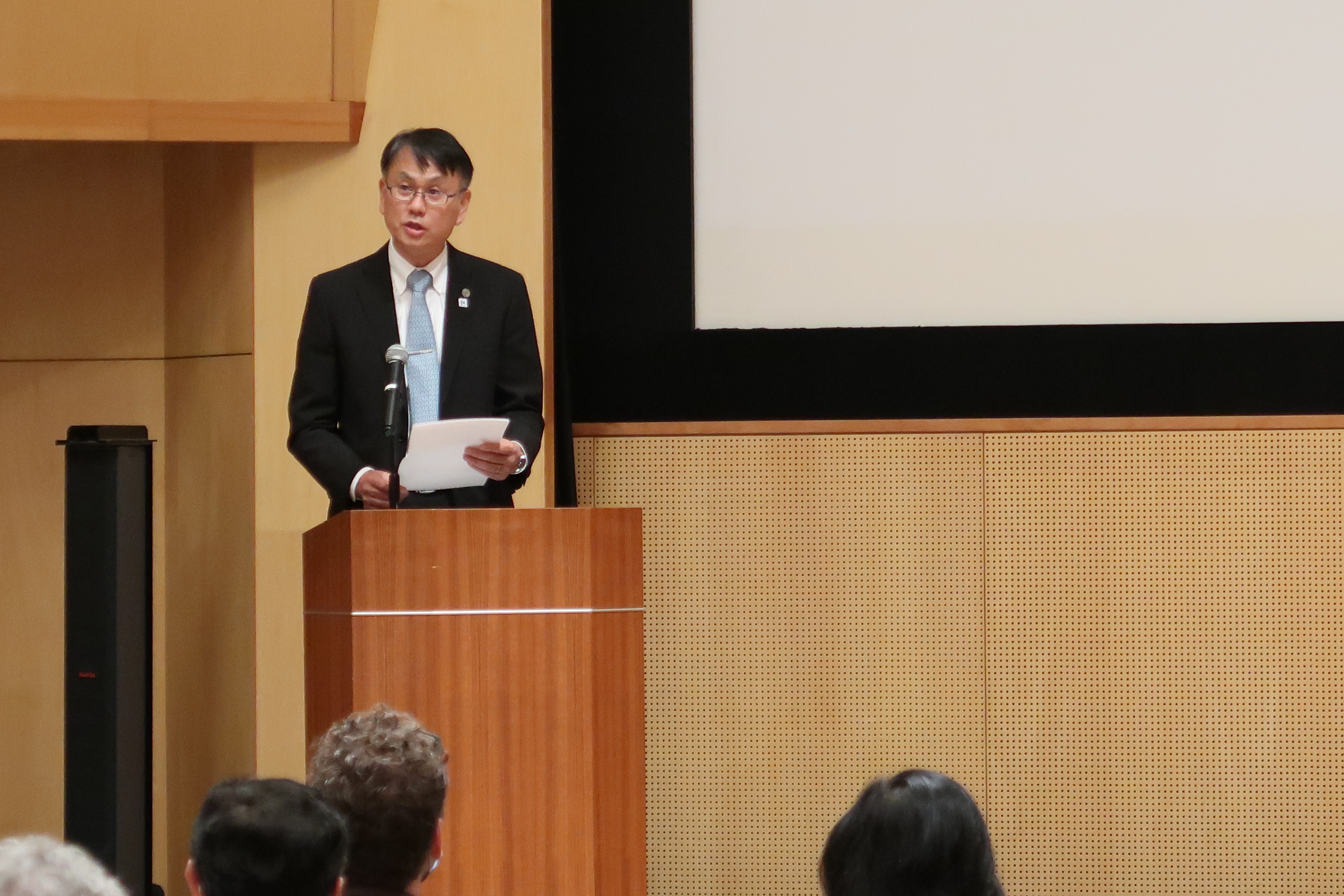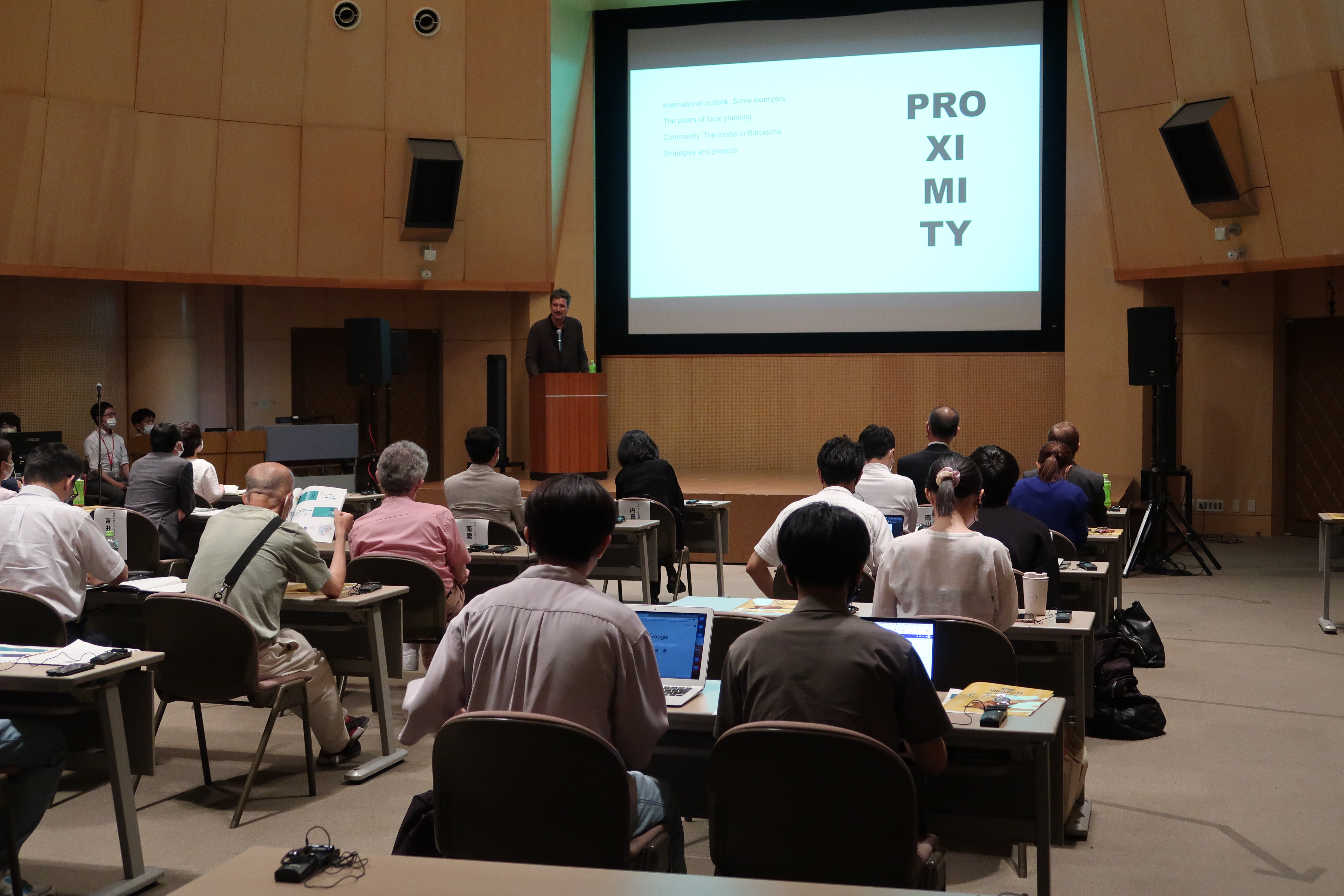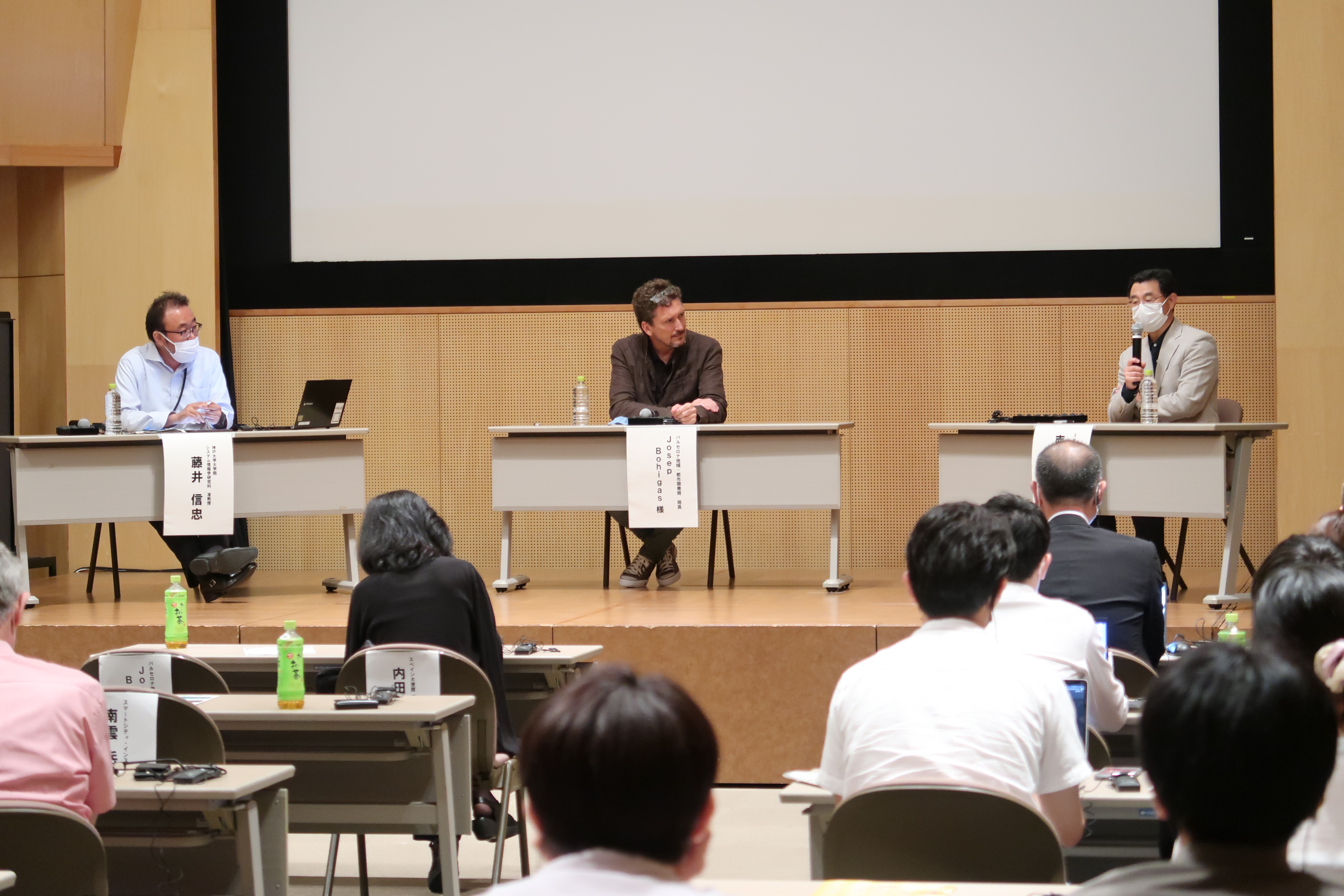Outreach Symposium “Current State of Smart Cities” was held on 23 June 2022
On June 23 (Thursday) 2022, Jean Monnet Centre of Excellence at Kobe University held an outreach symposium entitled “Current State of Smart Cities”. The symposium, which took place in hybrid form (both via ZOOM and on-site at Kobe University’s Rokko Hall), was attended by 92 participants online and 24 on-site. The event was co-hosted by the EURAXESS Japan and the EU Institute in Japan (EUIJ), Kansai and supported by Kobe-city, Hyogo Prefecture and the Economic and Commercial Office of the Embassy of Spain in Tokyo.
The symposium, which is a part of events commemorating Kobe University’s 120th anniversary, was opened by welcoming remarks from Prof. Tamotsu Nakamura (Executive Vice-President of Kobe University in charge of University Reform, Digitalization and Evaluation). Mr. Kizo Hisamoto (Mayor of Kobe) in the video message expressed his gratitude for the opportunity to introduce the smart city project of Kobe. Similarly, Mr. Michael Donaldson (Commissioner for Technological Innovation, e-Government and Good Governance of the Barcelona City Council) in his video message welcomed the opportunity to share Barcelona’s experience of using the latest technologies and noted that next year would mark the 30th anniversary of the twinning agreement between Kobe and Barcelona.
The following four presentations were then delivered. First, Mr. Yuji Okayama (Deputy Director General, Planning and Coordination Bureau, Kobe City Government) in his presentation “Smart City Initiatives of the Kobe City Government” highlighted that building a smart city from the perspective of actual citizens is the cornerstone of the Human x Smart City Kobe project. He demonstrated the project objectives and explained how the Consortium for promoting the project enables citizens and businesses to actively engage together with the government in activities that make use of modern technologies.
Second, Associate Professor Nobutada Fujii (Graduate School of System Informatics, Kobe University) in his presentation “Kobe University’s Initiatives for Smart City” showed the context behind the smart city project and emphasized that Kobe strives for a human-centric smart city. He illustrated how innovative experiments can be used to support the design of a smart city- for instance, Artificial Intelligence can estimate the human flow in Kobe’s underground city, which in turn can be used for adjusting the air flows and energy consumption.
Third, Mr. Takehiko Nagumo (Executive Managing Director of Smart City Institute Japan) in his presentation “Liveable Well-Being City Indicator- A New Smart City Approach from Japan” first pointed out that the United Nations’ World Happiness Report 2022 ranked Japan 54th in the world. Japan appears to rank low in terms of “freedom to make life choices”, which highlights the need to focus more on the LWC (Liveable Well-Being City) Indicator. Mr. Nagumo explained in detail the logic model of smart cities using the LWC Indicator and underlined that when various actors (government, industry, academia and citizens) cooperate to create the human-centric smart cities in Japan, the outcome of their cooperation should be in terms of LWC Indicator. In other words, smart cities should be a method, a means to improve people’s lives.
Fourth, Mr. Tatsuya Maisawa (Country Representative of EURAXESS Japan) in his presentation “EU-Japan Researcher Mobility” explained how the EURAXESS Japan promotes the mobility and research cooperation between the EU and Japan. He also noted that smart cities together with climate neutrality are included in the comprehensive strategy of Horizon Europe. Ms. Bernadett Köteles-Degrendele (Senior Advisor - Independent Expert) then shared her findings via a video message called “Smart Cities or Smarter Communities?”. She noted that the focus in the European digital transformation has changed from users to wider communities, which she illustrated by two examples- Digital Europe Programme (EU funding programme that brings digital technology to businesses and public administrations) and the Living-in.EU movement (city-led platform for cities and communities to accelerate their digital transformation).
Next, Mr. Josep Bohigas (General Manager of Barcelona Regional, Urban Development Agency) gave a talk entitled “Urgent and Progressive Urbanism in Barcelona”. He first showed that the proposals to improve citizens’ lives in urban areas have one point in common- the idea of proximity. He referred to a number of cities worldwide, which have implemented the “complete neighborhoods” that enable a comfortable access to necessary goods and services within a walking distance of 15 minutes. Barcelona, as a compact and diverse city, can reach the sustainable city model by focusing on the proximity urbanism. Mr. Bohigas explained Barcelona’s urban regeneration strategies by referring to concrete maps, diagrams and photos from the city. Out of multiple projects in Barcelona, he focused on the promotion of superblocks, which help to reduce air pollution and improve urban quality of public spaces.
Finally, the Panel Session, moderated by Assoc. Prof. Fujii, had two discussants-
Mr. Bohigas and Mr. Nagumo who focused on the following three points. Firstly, as proximity is a key word in urban planning, how should we view the physical and psychological distance now with many people working remotely due to the Covid-19 pandemic? Both discussants agreed that the pandemic caused us to regress, as people’s mobility was reduced, yet at the same time people were forced to reassess their identity within their neighborhoods. For instance, in Barcelona people decided to re-connect and recreate the neighborhoods where people know each other. Secondly, what distinctive design should Kobe follow, when building its smart city? Mr. Nagumo pointed that in general, citizens need to feel psychological well-being as well as excitement and that cities should better advertise their assets. Mr. Bohigas added that in his presentation the word smart city is not actually used, because smart city is a tool, a concept. He advised to start with having a model and then use technology. Thirdly, the discussants were asked about the importance of art in cities. Mr. Bohigas recalled how after the Franco dictatorship in Spain public places were set up in order to reflect on democracy and invite new ideas and art. Mr. Nagumo explained the importance of art by referring to the famous Maslow’s hierarchy of needs. Cultural assets relate to belonging needs (when people enjoy consuming art with others), self-actualization needs (when people want to express themselves and create arts) and self-transcendence needs (when people are motivated to support artists).
In his closing remarks Professor Masahiko Yoshii (Director of the Jean Monnet Centre of Excellence at Kobe University) reiterated the importance of digital inclusion, when the society cherishes people to ensure that no one is left behind during the digital transformation. He also expressed hopes of strengthening the collaboration between Kobe University and Kobe-city in building the smart city.
The symposium explored in depth the current state of smart cities in Europe and Japan and provided a forum for the exchange of ideas among the participating experts from Japan and Europe.





